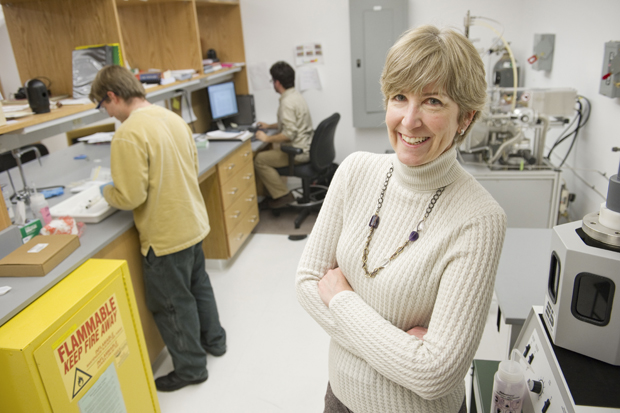Building a super magnet

Laura Lewis is leading a team of Northeastern researchers developing a super-strong magnetic material that has the potential to revolutionize the manufacturing, transportation and clean-energy industries. Photo by Mary Knox Merrill.
Super-strong magnets found in electronic devices such as computers and mobile phones play a crucial role in modern life, but the rare earth elements that power these magnets have fallen into short supply.
Last year, China, which has cornered the market on the supply of the rare earth elements, purposely reduced production by 40 percent to drive up prices throughout the rest of the world.
But Northeastern University researchers are leading a project to solve the problem. Backed by a $3.5 million grant from the Department of Energy (DOE), principal investigator Laura Lewis, the Cabot Professor of chemical engineering in the College of Engineering, Vince Harris, the W.L. Smith Chair Professor of electrical and computer engineering, and colleagues from five other institutions, including General Motors Research and Development, will work together to engineer new magnetic materials that do not utilize rare earth elements.
Lewis said a new material has the potential to revolutionize the manufacturing, transportation and clean-energy industries. “We’re working to manipulate material structures at the atomic level to develop superior magnetic properties,” she explained.
The research team will work to design a new material through the Rare Earth Alternatives in Critical Technologies for Energy (REACT) Program. The DOE Advanced Research Projects Agency—Energy initiative created the program to reduce the reliance on rare earth elements, which, Lewis said, “happen to be extremely important to an enormous number of technologies critical to the United States.”
There are plans to revive long-dormant rare earth mines both in the U.S. and abroad, but the work by Northeastern researchers and their collaborators will facilitate the creation of environmentally friendly alternatives with a secure, domestic supply chain.
China currently mines and produces more than 95 percent of the rare earth metals used worldwide. “China has concluded that it needs to retain its rare earth supply and production to meet its own growing energy needs,” Lewis said.
China’s stance prompted the U.S. federal government to allocate significant funding to develop the magnets without Chinese materials. One alternative material currently under review is cobalt carbide, which Harris and his colleagues at Northeastern’s Center for Microwave Magnetic Materials and Integrated Circuits used to produce the world’s fourth most powerful magnet, which does not rely on rare earth metals.
Visit IRis, Northeastern’s archive of digital scholarship, publishing and preservation for work by Laura Lewis and Vince Harris.





